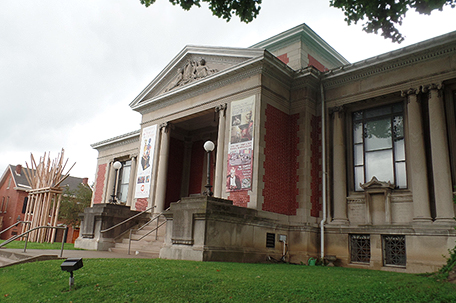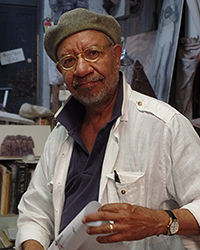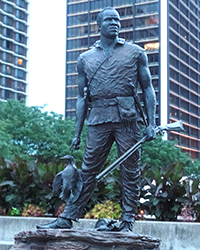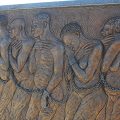
ABOVE PHOTO: Carnegie Center
By Renée S. Gordon
Every state has a unique story that explains how it developed into the place we visit today. Geography is the single largest determinate and the character of the people drawn to the area are the next most important factor.
The region we know as Kentucky has always been a haven for individuals of strong opinions and personal moral commitment. The state, with its key position on the border between the North and South, was the only state to be represented with a star on the flag of the Union and the Confederacy during the Civil War and both Abraham Lincoln, the President of the Union and Jefferson Davis, the President of the Confederacy, were born in Kentucky. To delve deeper into the state’s story, one can elect to follow one of the numerous thematic trails created by the state or “go rogue” and tour some of the lesser-touted sites. Considering what Kentucky is all about that is the only way to go.
Archeological excavations have proven that Native Americans inhabited the area for at least 11,000 years prior to European contact and the name of the state itself is believed to be a derivation of the Cherokee word “Kenta,” meaning meadow. Seventeen years ago, the Kentucky Legislature honored the ongoing contributions of the state’s native population by establishing Kentucky Native American Heritage Month.
La Salle, a French explorer, is believed to have reached the region in 1669 and four years later Gabriel Arthur became the first Englishman to arrive. In 1739, Captain Charles de Longueuil explored the region and claimed the land for France. Various traders and frontiersmen followed including Christopher Gist in 1750 who surveyed the Ohio River to what is Louisville. In 1774 and 1775, two former Pennsylvanians, James Harrod and Daniel Boone accompanied by his slaves, founded Harrodsburg and Boonesborough and in 1783 the Treaty of Paris ceded the entire territory to England. It was part of Virginia until June 1, 1792 when it was admitted to the Union as the 15th state.
Fort Nelson on Corn Island became the first permanent settlement at the Falls of the Ohio River in May of 1778. George R. Clark, several hundred men and settlers landed on the island and proceeded to plant corn for sustenance. Later that same year, the settlers relocated to the mainland and the next year area land went on sale. In 1780, the newly chartered city was named Louisville to honor the French king, Louis XVI, who had been a valuable ally during the American Revolution, William Pope laid out the city and Daniel Sullivan divided the area into individual lots. gotolouisville.com
The first documented black resident was Cato Watts, an enslaved worker belonging to Captain John Donne. Donne and Watts were among the original settlers on Corn Island. In 1787, Cato accidentally murdered Donne and was executed as Louisville’s first documented murderer. Cato is also listed as having been a superior musician and accounts state that his fiddling was sorely missed.
A key to an extraordinary visit to Louisville is your choice of accommodations and the 91-room 21c Museum Hotel sets the perfect tone for this city tour. The hotel is located on Main Street, within walking distance of the majority of the city’s most visited sites and attractions in five bourbon and tobacco warehouses that date from the early 19th-century. It offers boutique lodging, a complete menu of amenities, and a contemporary art museum that features both dedicated galleries and art throughout the structure. On the hotel’s exterior stands their most arresting artwork, a 30-ft., gilded, replica of Michelangelo’s David. Artist Serkan Ozkaya is said to have never seen the original but based his work on a computer generated model. The 21c is consistently honored and recently received “Travel + Leisure’s” Global Vision Award. Proof on Main, the hotel’s restaurant, is the winner of the “Best American Hotel Bar Award.” 21cmuseumhotels.com/Louisville
Because waterways were our first roads, and there were only two viable land routes into Kentucky, the Ohio River played a significant role in the history of Louisville. The Belle of Louisville and the Spirit of Jefferson are boats that offer narrated sightseeing tours and dinner, Bourbon and specialty cruises. The Belle is the oldest steamboat of its kind still in operation. Highlights of the scenic tour are panoramic views of Louisville, the Lincoln Memorial, the George Rogers Clark Bridge, seen in the movie “Stripes” and the John F. Kennedy Bridge. The Kennedy Bridge was the first completed after JFK’s assassination. belleoflouisville.org/the-spirit-of-jefferson
The Belle and the Spirit are docked on the waterfront near Fourth Street at approximately the point where Lewis met Clark on October 14, 1803. A plaque indicates the historic importance of the site. Located on the Belvedere a level above the waterfront is a statue of York, William Clark’s African American slave who accompanied them on the journey and was a voting member of the expedition. He did not, like the other members of the Corps of Discovery, receive any monetary remuneration or his freedom. The bronze sculpture was created by noted African American artist Ed Hamilton and dedicated on October 14, 2003. York is depicted as a noble figure with all the accouterments of the voyage, just “as the Indians would have seen him.” The natives had never seen a black man before and they attributed him with having great spiritual power. York faces the Ohio River and the adjacent statue of Louisville founder George Rogers Clark by Felix de Weldon points toward the river.
Further along the shoreline, in Waterfront Park, another of Ed Hamilton’s masterpieces is situated. A 12-ft. Abraham Lincoln is seated on a rock looking toward the Ohio River, two books and his top hat rest beside him. The walkway that leads to the sculpture is adorned with four bas-reliefs that feature Lincoln’s links with Kentucky. The four themes depicted are Lincoln’s Kentucky youth, his political and social life, the Civil War years and his views on slavery and Emancipation. An onsite amphitheater showcases carved quotes from Lincoln. Edhamiltonworks.com
Lincoln’s favorite author was William Shakespeare and no less than three references are carved on the amphitheater surround. Lincoln developed his love of books in Kentucky and Louisville continues to foster that love of reading in general and Shakespeare specifically by supporting the Kentucky Shakespeare Festival. The festival, an annual event since 1960, is presented in Central Park at no cost and is the longest running festival of its kind in the United States. kyshakespeare.com
Louisville is best known as the home of the Kentucky Derby, America’s longest running sporting event and a visit to the Kentucky Derby Museum at Churchill Downs is a must whether you are a race fan or not. The Derby, held the first Saturday in May, is billed as “the most exciting two minutes in sports and is first in the series of three races, including the Preakness and the Belmont Stakes, that comprise the United States Triple Crown. The track is a 1.25-mile oval dirt course on which no more than 20 three-year-old Thoroughbreds can compete in the race. The crowd averages 150,000 people and the average total amount betted is $189-million. Bets are taken until 60-seconds before post time and are taken in cash only. The largest bet to date, made in 2014, was $1-million bet on Candy Boy. Candy Boy placed 13th. churchilldowns.com
William Clark’s grandson established Churchill Downs, then the Louisville Jockey Club, and the first race was run in 1875. The winner of that race was an African American jockey, Oliver Lewis. The British brought the sport of horse racing to America and colonial jockeys tended to be slaves because it was largely a sport for southern gentlemen. Andrew Jackson was known to have brought his prized Thoroughbred to the White House along with his enslaved jockey. Of the first 28 winners of the Kentucky Derby 15 of the jockeys were black but by the early 20th-century black jockeys no longer appeared in the race and the next black jockey was not a participant until 2000. There is a display on the second level, “African Americans in Thoroughbred Racing” that contains several artifacts relating to Isaac Murphy the most famous of the early black jockeys.
The Kentucky Derby Museum features 32 exhibit areas on two levels. “The Greatest Race,” a 360-degree orientation movie, is regularly scheduled in the Great Hall. Many of the areas are interactive, Jockey Silks, Call the Race, Place Your Bets and Riders Up, and provide great photo ops. Exhibits on the grounds include a stable complete with retired Thoroughbreds. On the Kentucky Oaks Terrace there are memorials to five Derby winners and one to Eight Belles, a 2008 runner-up, who was so injured that he had to be put down on the track. The Barn and Backside Tour and Inside the Gates Tour are special guided tours that can be reserved. The Derby Café and Finish Line Gift Shop are also part of the complex. Derbymuseum.org
One of Louisville’s neighbors’ most extraordinary exhibit spaces is the Carnegie Center for Art & History. The Center is located in New Albany, Indiana and showcases contemporary art, scheduled events and programs and both permanent and changing exhibits. sunnysideoflouisville.org
“Grandpa Makes a Scene: The Yenawine Dioramas”, is a series of 12 dioramas that depict historic scenes from Georgetown, Indiana and two Pilgrim scenes. From 1944 to 1958, Merle Yenawine handcarved scenes and placed them on his porch at Christmas to the delight of his neighbors. The dioramas are completely mechanized and lights glow and people move. They are totally unique.
“Ordinary People, Extraordinary Courage: Men and Women of the Underground Railroad” is the featured exhibition that takes visitors on an interactive journey through the antebellum borderland of Indiana and Kentucky. The trip is accomplished with the use of video, photographs, artifacts and documents. Six orientation vignettes provide historic background and an overview of the people and places connected to the Underground Railroad.
The emphasis is on the stories of individuals and “Remembered: the Life of Lucy Higgs Nichols,” relates the story of Lucy’s 1862 escape from enforced servitude and subsequent nursing service with the 23rd Indiana Regiment. A Special Act of Congress granted her a pension for her wartime service in 1898 with the full support of the 23rd. carnegiecenter.org
Dining in and around Louisville invites you into a world of creative menus and food preparation.
Mesh opened less than one year ago and features unique twists on southern comfort food in a casually elegant setting. The food here is excellent and you should not leave until you have tried the artisan breads and shrimp and grits. meshrestaurants.com
Buck’s Restaurant and Bar is one of the most highly rated fine dining restaurants in Old Louisville. Everything here is delicious but don’t miss Lamb Chops “Madagascar.” Buck’s is undeniably elegant, decorated with white flowers and offering impeccable service. It is a masterful choice for a special evening. buckslou.com
Information on planning a trip to Louisville, and Maysville, Kentucky, featured in part two, is available online. kentuckytourism.com
I wish you smooth travels!
Travel Tips:
Events and activities planned around the Pope’s visit to Philadelphia are gearing up and the Penn Museum will present their exhibition, “Sacred Writings, Extraordinary Texts of the Biblical World,” from August 15th through November 7th. The texts span more than 3,000 years and include a Mesopotamian flood story that predates the Biblical account of Noah. penn.museum
The World Meeting of Families (WMF) will take place in Philadelphia from September 22-25. The theme of the conference is “Love is Our Mission: The Family is Fully Alive.” In 2006, Helen “Honey” McVey lost her battle with lung cancer. That same year Cathy Palmer McVey created a family run charity, Honey’s Angels, to honor the memory of her mother and exemplify the message of the WMF. The week of the conference the McVey family will, through their Random Acts of Honey Program, distribute a minimum of 25 $25. Wawa gift cards to homeless people in Center City. The charity engages in assisting families of all denominations and from all neighborhoods referred to them by religious institutions, government agencies and individuals. Go to the website to learn more and see how you can help. honeysangels.com
Recommended Reading:
Edward Hamilton, “The Birth of an Artist”
Edward Hotaling, “The Great Black Jockeys: The Lives and Times of the Men Who Dominated America’s First National Sport”


















Leave a Comment